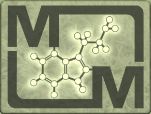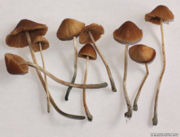 |
MAGISKA MOLEKYLERS WIKI |
Conocybe cyanopus
Namn: Liten klockh├żtting. ├även k├żnd under namnet gr├Čnfotsh├żtting
Inneh├źller: psilocybin, psilocin, baeocystin, sp├źr av norbaeocystin och aeruginascin
Generell information
Liten men potent svamp i sl├żktet Conocybe. V├żxer i Sverige. Ganska s├żllsynt.
Kan m├Čjligen hittas i samma habitat som Conocybe smithii), en art som ├żven p├źtr├żffats i samma habitat som Psilocybe semilanceata av knarkkorven[1][2], gr├żs med mycket vitkl├Čver med inslag av f├Črmultnad bark/tr├żsp├źn fr├źn gran. Avrinning fr├źn ko├żng, mycket vattenansamlingar, v├żlg├Čdslat. Kan vara en koppling till vitkl├Čver eftersom det ├żven f├Črekommer p├ź andra foton[3]. B├żsta identifikationsmetoden f├Čr att se om det ├żr r├żtt art ├żr att den snabbt blir bl├ź l├żngst ner p├ź foten (se fotot till h├Čger). ├är hygrofan, halmgul som torr, orangebrun som v├źt, strimmig i hatten. Unga exemplar har r├Čdbrunare hattf├żrg.
Varning! Det finns giftiga Conocybe och m├źnga av arterna i sl├żktet ├żr mycket lika Conocybe cyanopus och ├żr dessutom betydligt vanligare. Ovana plockare b├Čr INTE f├Črs├Čka plocka eller ├żta svampar med orange/bruna skivor. G├Čr du fel s├ź riskerar du att d├Č! Leta efter andra svampar ist├żllet!
Lite om skillnaderna mellan C. cyanopus och C. smithii:
| ŌĆ£ | WATLING (in BENEDICT & al. 1967) has seen fresh material of this species, which is rather common in North America, and he mentions the following differences to Pholiotina cyanopus (G.F.ATK.) SINGER: The lamellae are more cinnamon brown in C.smithii, the pileus is paler and moist more distinctly striate, the fruit bodies are more delicate and smaller, the spores narrower, the number of pileocystidia smaller and the cheilocystidia wider and have a less distinct capitulum. Unfortunately, the differences in spore size and form given in STAMETS (1999) are incorrect, as a comparison of both type specimens shows (means of both specimens almost identical). Also the different number of pileocystidia is not confirmed in our studies. Therefore, the only confirmed differences concern the somewhat wider cheilocystidia of Pholiotina smithii and some macroscopical differences. A detailed analysis of European material of sect. Cyanopodinae (SINGER) ARNOLDS is still missing, and as we know Pholiotina smithii only from herbarium specimens, we tentatively agree with WATLING (in BENEDICT & al. 1967) and consider that it is a distinct species. In case of conspecificity, Pholiotina cyanopus is the valid name due to priority reasons, as it has been published a few months earlier ŌĆö Hausknecht (2004)[4] |
ŌĆØ |
Om inneh├źllet
Enligt en referens 0,87% psilocybin, 0,15% baeocystin[5]
Beug and Bigwood (1982b) found 0.93% Psilocybin but no psilocin. Christiansen et al. (1984) reported ranges of 0.33-0.55% Psilocybin and 0.004-0.007% Psilocin. Gartz (1992) found 0.78-1.01% Psilocybin, no psilocin, and 0.12-0.20% baeocystin.[6]
En studie fr├źn 2015 hittade f├Čr f├Črsta g├źngen sp├źr av aeruginascin i P. cyanopus:
| ŌĆ£ | The content of psilocybin was found to be high (0.90┬▒0.08% of dry weight), besides, analysed samples contained lower concentrations of psilocin (0.17┬▒0.01%), and baeocystin (0.16┬▒0.01%). Additionally, the chemical analysis revealed
small amounts of norbaeocystin (0.053┬▒0.004%) and aeruginascin (0.011┬▒0.0007%) for the first time in the species. |
ŌĆØ |
Externa l├żnkar
- Ōåæ Magiska Molekyler: Conocybe cyanopus (m├źnga foton)
- Ōåæ Shroomery: Conocybe cyanopus. (I found them! wohooo!) knarkkorvens fynd av C. smitii
- Ōåæ Shroomery: WOW blueing Conocybe
- Ōåæ Type studies in North American species of Bolbitiaceae belonging to the genera Conocybe and Pholiotina (Hausknecht, 2004)
- Ōåæ Benedict, Tyler & Watling (1967); Benedict et al. (1962); Beug & Bigwood (1982); Christiansen, Rasmussen & H├Čiland (1984); Gartz (1992b); Gartz (1993a); Gartz (1996); Ohenoja et al. (1987).
- Ōåæ Shroomery: Conocybe cyanopus
- Ōåæ Pholiotina cyanopus, a rare fungus producing psychoactive tryptamines (Halama, 2015) alt. l├żnk
Sidan ├żndrades senast 15 oktober 2022 klockan 15.31.
Den h├żr sidan har visats 14┬Ā171 g├źnger.












